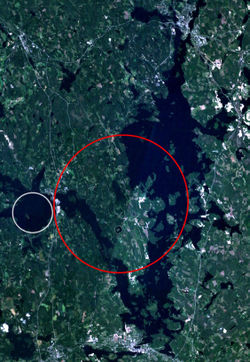Keurusselkä
2007 Schools Wikipedia Selection. Related subjects: European Geography
Keurusselkä is a lake in Central Finland between the towns of Keuruu to the north and Mänttä to the south. It covers an area of 117.30 km². Its average depth is 6.4 m with a maximum depth of 40 m. The surface lies at 105.4 m above the sea level. The lake is 27 km long and is a part of the Kokemäenjoki water system. Keurusselkä gained international publicity in 2004 when a pair of amateur geologists uncovered an ancient impact crater on the western shore of the lake.
M/S Elias Lönnrot, one of the two paddle steamers in Finland, makes regular tourist cruises on the lake in summer.
Environmental issues
In 1986, the Keurusselkä region was heavily contaminated (70 kBq/m²) by radioactive caesium ( 137Cs) from the Chernobyl disaster fallout. In 2003, some fish near Mänttä had still caesium concentrations several times as high as in Olkiluoto and Loviisa, which host the nuclear plants of Finland. This is due to the difference between the uptake of caesium in fresh water and brackish or saline water. However, the concentration levels are so small that eating the fish is not considered a health risk.
Apart from radioactivity, the water quality is also weakened by humic substances and local sewage. Despite that, the water quality is generally good, and the central part of the lake is in almost pristine condition. The lake is considered good for fishing, and the pike (Esox lucius) and perch (Perca fluviatilis) populations are especially large.
Keurusselkä impact structure
Keurusselkä covers an ancient impact crater remnant, which was discovered in 2003 by amateur geologists Jarmo Moilanen and Satu Hietala. Shatter cones, horsetail-shaped formations in rocks specifically formed in meteor impacts, have been found in an 11.5 km wide area, but it is possible that the area containing shatter cones may be only the central uplift of the crater. Weak traces based on digital elevation data suggest possible ring structures from 10 km to as wide as ca. 30 km in diameter. This would make Keurusselkä the largest impact structure in Finland surpassing the Lappajärvi crater. In addition to the shatter cones, microscopic studies of samples from a breccia boulder have revealed shock metamorphic features, ( planar fractures and planar deformation features) in quartz grains, which formed when the rock underwent extreme shock pressures of ca. 7–35 GPa.
The age of the crater has not yet been established, but it must be less than 1.88 Ga (thousand million years; Orosirian, in the late Paleoproterozoic), because that is the age of the Central Finland Granite Complex, the local granite bedrock. Since the impact, 7–8 km of rock has eroded away, leaving no visible depressions. It is clear that the crater is very old, possibly over 1 Ga because the other Finnish craters of that age still have some crater depression left (see Iso-Naakkima, Lumparn).
Sparse gravity data shows a negative anomaly (an area of lower gravity) in the area of the impact structure. However, there are other negative gravity anomalies nearby which are not believed to be related to the impact event. In addition, there are less dense felsic rocks in the western shore of the lake, which can contribute to the gravity low. The anomaly will be mapped in a much greater detail to determine if it is related to the impact event.
Airborne magnetic data show a strikingly circular magnetic anomaly, but for a reason not yet known it is slightly east from the gravity low area as well as the region where the shatter cones are found. It is possible that the ring was created for example by a granitic intrusion instead of the impact event. No specific anomalies have been found from radiometric or electromagnetic data. Paleomagnetic data will be collected to define the age of the structure.
Only some 30 km east from the centre of the Keurusselkä impact structure is Karikkoselkä, a much smaller and younger impact crater. Ukonselkä, a roughly circular lake immediately west from Keurusselkä, is listed in the suspected Earth impact site database (SEIS). However, no evidence for an impact there has been provided so far.
